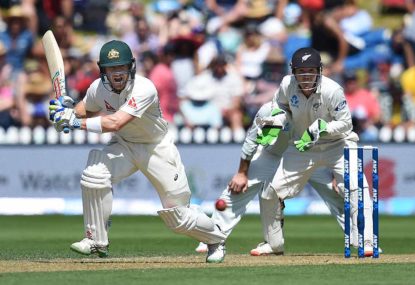RIP, David Lord: Australian sports journalism icon was 'always thoughtful and thought-provoking'
David Lord has been remembered as an icon of Australian sports journalism following his death, aged 84. The renowned writer and broadcaster was an…

Australian cricket is facing a grim challenge. They are desperately in danger of becoming what every Australian despises, becoming what they hate.
Home-track bullies. It is the harsh reality.
Watching Australia bat overseas is often like watching an awful X-Factor audition. It is a train-wreck, and extremely painful to watch, but you just can’t look away.
For years, Australia has struggled overseas, ironically mirroring that singer who hopes against hope but builds themselves up for an ultimately crushing failure.
At home, they are invincible. Nobody can touch them, they are the Hulk Hogans, the Supermen, they look as good as Bradman.
Usman Khawaja, Mitch Marsh and Joe Burns all look fantastic. And you would expect them to, on wickets that offer little to nothing for tired pace bowlers, and spinners with their fingers bloodied and blistered.
Overseas, however, is an entirely different story.
Since the retirements of some of the greatest cricketers in cricketing history, such as Shane Warne, Glenn McGrath, Ricky Ponting and Adam Gilchrist, Australia has struggled in nearly every tour, barring the tumultuous nation of the West Indies.
The Australians have not won in India since 2004, not in England since 2001 and have struggled badly against Pakistan in Dubai, and now, Sri Lanka in their own homeland.
Yes, today was finally a good day for the Australians after two straight Tests in which they got demolished. Yet, it serves as little more than a consolation prize to Australian fans, who have witnessed a series dominated by the Sri Lankan spinners.
Click here for The Roar’s live blog to keep up to date with the Australia versus Sri Lanka Test.
All in all, the Australians themselves are in a spin. They don’t know what to do, Rod Marsh reminds me of myself in math class, he simply doesn’t have the answers.
“What else can we do really? We send them off to India, we send them to other parts of the world where the ball turns, we played an ‘A’ series in India last year and they batted well against good spin bowling.”
And Marsh is right for the most part. They have created hybrid wickets up at the National Performance Centre, sent tour groups to the subcontinent, and even have thought to select specialist batsmen for upcoming tours.
Yet, the most integral part into making sure Australian cricketers are able to adapt to conditions does not start with overseas countries, the start to the solution is right here in Australia.
Once upon a time, in a place not really that far away, Australian cricket was defined by its separate states.
Queensland was a bouncy green top, while the WACA was a fast bowling paradise. Hobart swung like crazy, while the Adelaide Oval was a batsmen’s dream. The MCG offered a little bit for every player, while the SCG was a dustbowl for the spinners.
Ah, how times have changed. We look back on these times with nostalgia and joy, but today’s cricketing landscape is home to lifeless pitches, defensive spinners and flat-track bullies.
It is all well and good to create a wicket which simulates sub-continent conditions. To send a tour group over to India and have them play quite well, but nothing can compare to real matches in which the batsmen are challenged by different conditions.
All wickets nowadays in Australia are more or less the same, with the exception of those up in the Northern Territory, which are the only type of pitches that actually seem to spin.
This restricts batsmen from improving in difficult conditions, and they have these hugely inflated averages against bowling attacks that are depleted of any real threat due to the lack of help from the wicket.
It also disadvantages the bowler, who is offered nothing from these conditions, and spin bowlers are forced to bowl defensively in order to maintain their spot, because they sure as hell aren’t getting much spin out of these wickets.
You simply cannot expect batsmen such as Marsh, Khawaja and Burns to perform on subcontinent and English wickets if they do not experience it in first class cricket.
By this same token, you cannot expect the up-and-coming young batsmen like Matt Renshaw, Peter Handscomb or Sam Heazlett to succeed in uncommon conditions when their eventual Test debuts come.
Or for bowlers such as Mitch Swepson, Fawad Ahmed, Adam Zampa or Stephen O’Keefe when they are given little to work with on flat wickets.
If Australia want to improve their record overseas, they need to start out with their wickets.
Give batsmen a challenge, give bowlers something to work with and we may start to see results.
In a world where change is necessary, and we are constantly told to look to the future, maybe we can take some lessons from the past. Maybe we can take some lessons from one of the most successful periods in Australian cricket, in order to become a better cricketing side.
Otherwise, all we really are is a bunch of home-track bullies.